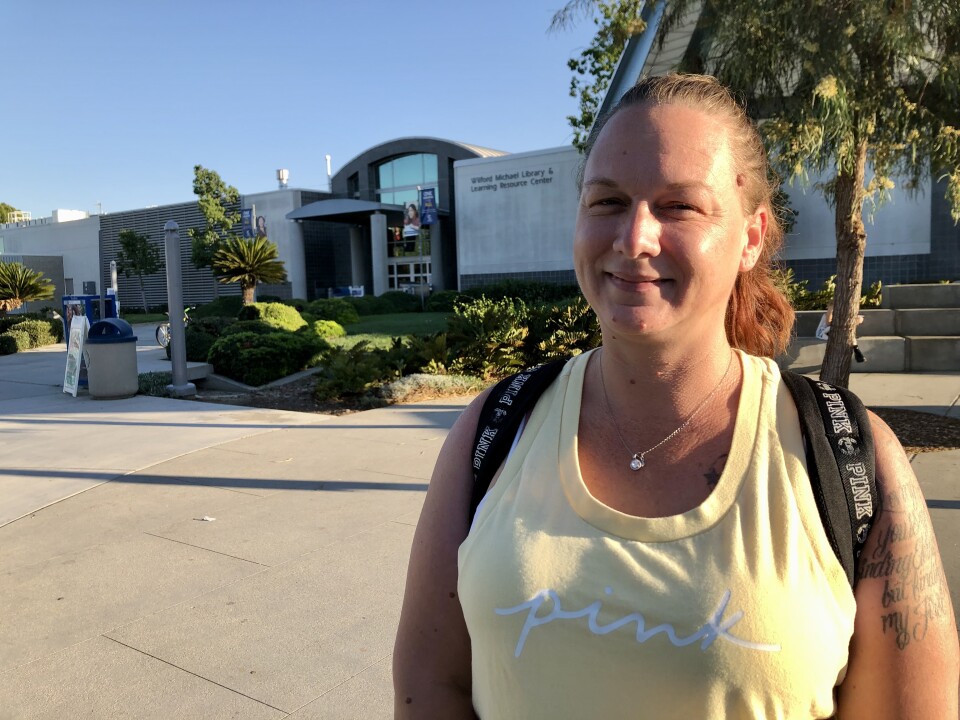Truth matters. Community matters. Your support makes both possible. LAist is one of the few places where news remains independent and free from political and corporate influence. Stand up for truth and for LAist. Make your year-end tax-deductible gift now.
A Lot Of California College Students Can Get Free Money For Food. Here's How

The pandemic, rent increases, gas costs, and supermarket prices are leading to this:
“College students are applying for CalFresh in a significantly higher amount than we've seen in the past,” said Aaron Kunst, a project manager at the Center for Healthy Communities at Chico State.
Not just a higher amount — a 300% increase, said Kunst, who works with about 50 California colleges.
COVID and the economy are only partly behind the growth. Kunst and others say the changes California and federal policymakers approved in recent years have made more college students eligible for the benefit. And campuses are getting better at putting that information in front of more college eyeballs so more students can take action and apply.
According to a report released in 2020, more than 127,000 California college students received CalFresh, but more than four times that number qualify.
In 2021, Sacramento gave each of the state’s public higher education systems a one-time allocation so campuses could open the CalFresh door wider for their students. The California community colleges received $3.1 million, the California State University system $1.3 million, and the University of California $650,000. Campuses were to use the funds to improve outreach and help students through the application process.

After students fill out the application and it gets approved, they can expect to receive about $280 every month that’s loaded onto a CalFresh debit card. Yeah, it’s not buckets of ducats. Keep reading and you’ll hear from a student about that.
Are You Eligible For CalFresh?
Students have to meet certain criteria to be eligible for CalFresh, but all applications have baseline requirements:
- Official identification
- Proof of college attendance (at least half-time)
- Proof of income
- Proof of legal U.S. residency if you’re not a citizen (DACA students aren’t eligible)
As of 2021 the federal government has temporarily expanded eligibility. Here’s the expanded criteria:
- College student in a federal- or state-financed work study program
- Your federal financial aid says that your family’s contribution is zero ($0)
This expansion will end when the federal government ends its national emergency order.
But you might also qualify under non-COVID circumstances. There are a host of those, including, among others:
- You work a paid job at least 20 hours a week
- You receive federal or state work-study money
- You participate in an on-the-job training program
- You're approved for a TANF-funded Cal Grant A or B
- You're enrolled in a program to increase your employability
- You're enrolled in Extended Opportunities Programs and Services
- You have a child (based on the child’s age and your access to child care)
Here’s a good website with more eligibility information.
Here’s the very important CalFresh website where you can apply.
If you don’t live in California, here's information for most of the other states.
But, you may ask, why would I need help if policymakers have tried to make the process easier? Well, we’ll get to that at the end.

Why Don’t College Students Know They Qualify?
Advocates say outreach is spotty to college students depending on the campus.
Why Is Getting CalFresh So Hard?
As applications for CalFresh surge at California colleges, college staff warn that the application process remains cumbersome and bureaucratic. These difficulties can lead students to quit the application midway and create negative word of mouth.
And policymakers have heard this, too. Here's what's causing delays, and what actions might help.
Most college students in California attend a campus that’s part of the University of California, California State University, or community college systems. Advocates say University of California campuses have devoted the most resources to starting programs to help students apply for CalFresh benefits. Some campuses inform students on their financial aid forms if they’re CalFresh eligible, but not all do.
Cerritos College emails their students a lot.
“I get $250 a month on the second of every month,” said Cerritos College nursing student Heather Meninga.
She signed up right around the time the pandemic started. She said the campus sent her emails a couple of times a month.
“It's worth it, it helps,” she said. “But it's definitely only a very small part of what we use for grocery shopping. So it would definitely benefit us to get more, but it does get used.”
For about five years, California college administrators and advocates have pushed state lawmakers to expand their thinking about college costs beyond tuition. And that’s led Sacramento to devote funds to help college students pay for books, transportation, rent, and food. But the CalFresh benefit can be tough to get.
“To receive CalFresh benefits as a student, the application process is incredibly complicated,” said Brandi Simonaro, a project manager at the Center for Healthy Communities at Chico State.
She and others warn students to be patient.
“It took about three months to get the approval," Meninga said. "And I had to start over a couple of times.”








